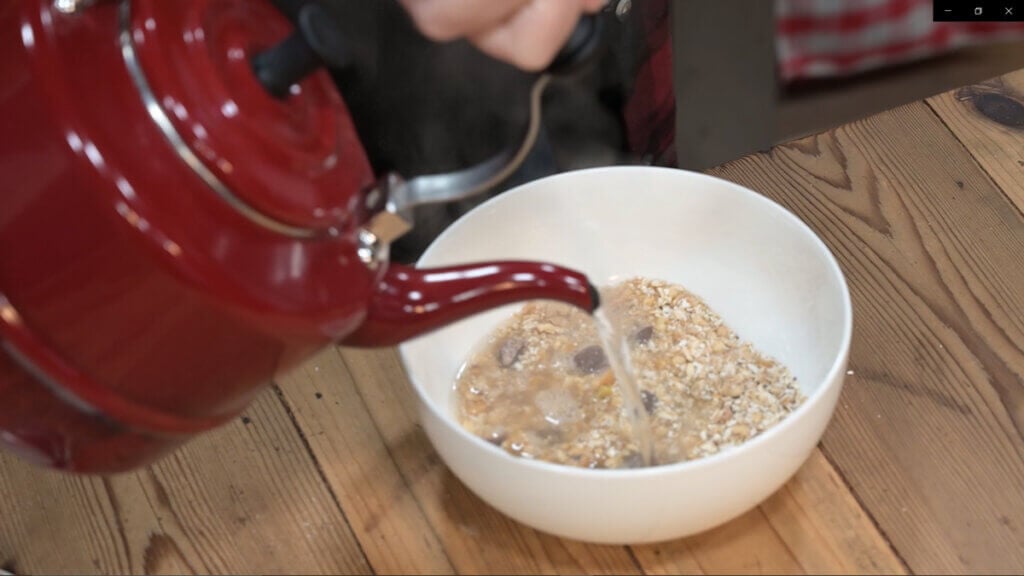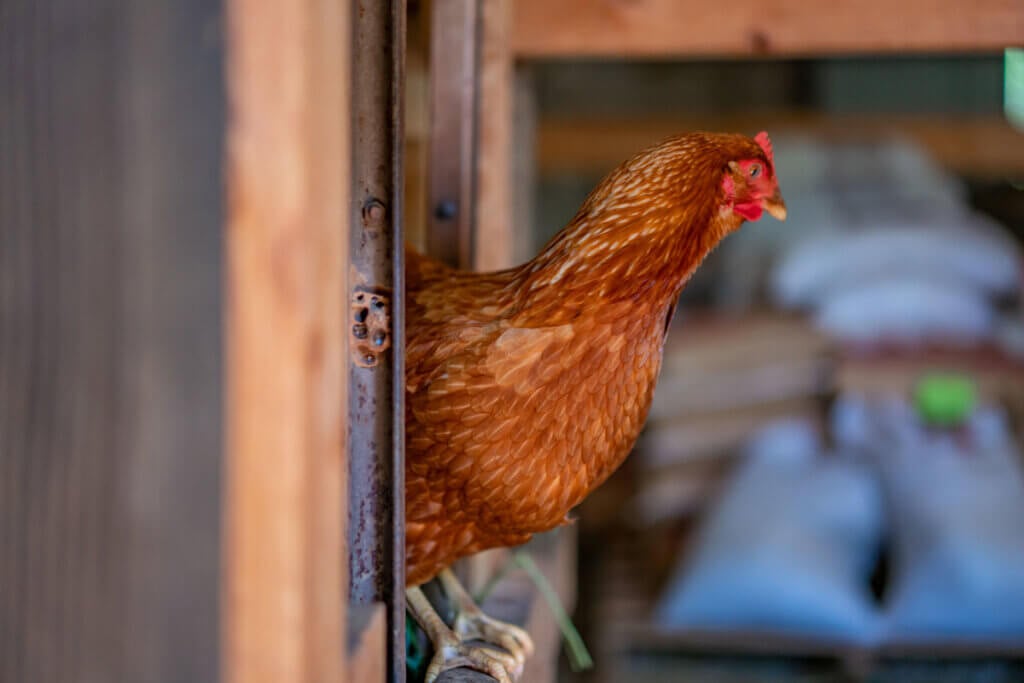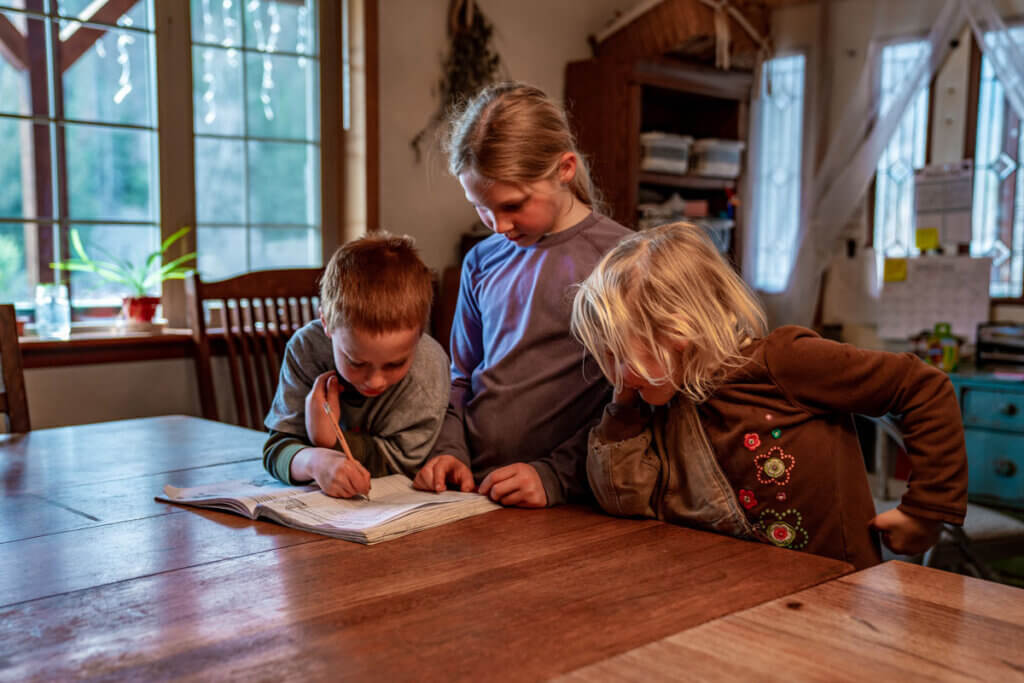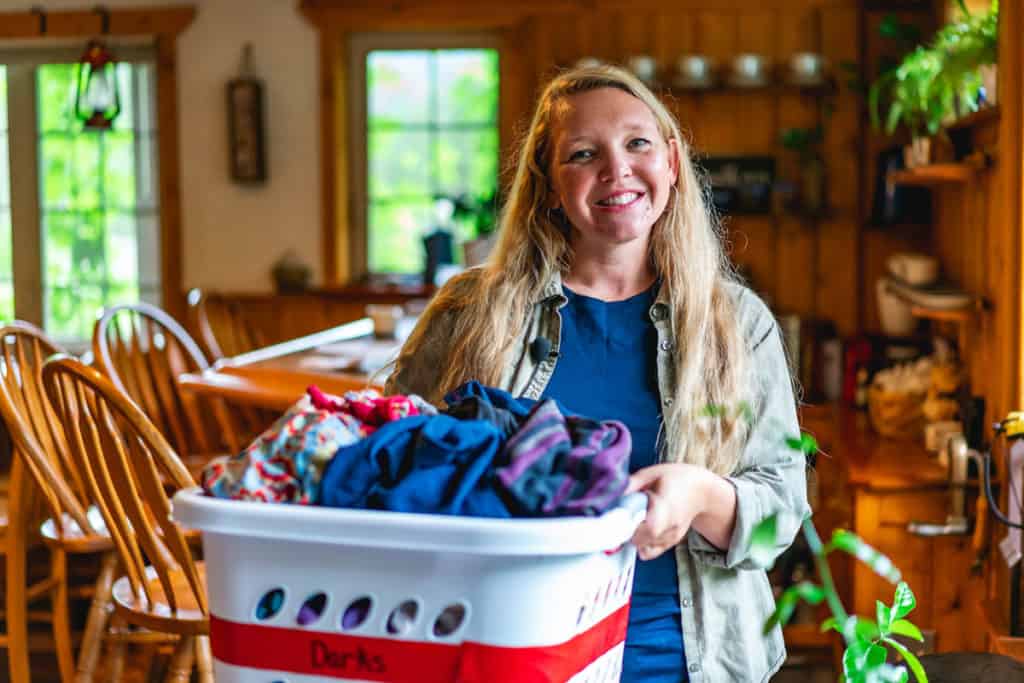Having age-appropriate chores for children teaches them responsibility and essential life skills. Chores build self-worth and lay the foundation to develop their own self-sufficient lifestyle.

With this simple, easy-to-follow method, you don’t need a chore chart to help a child gain a step up in life. Get the best ideas here to motivate any age group regarding chores for kids with this household daily guide. Read on to learn how!
Our Morning Chores for Kids
Our household is large and busy with differing ages of children and multiple chores that require time and proficiency every morning on the homestead. The importance of chore time for kids and teaching our children how to have a productive morning gives us a good start to the day.
We value structured household chores to benefit our children and homestead. We all have a morning routine for a productive day and realize the importance of age-appropriate chore jurisdictions to build skills and personal success for each child.
One of my secrets to running a productive household is assigning the morning chore for each child for six months before rotating to another assignment. This consistency allows each child to achieve their morning routine while mastering the assigned task, setting them up for success.
Morning chores (and evening chores) don’t have to be burdensome and a dreaded event. I find having a good attitude brings a helpful heart. I strive to impart ideas and creative ways to see chores as something that benefits the family and gives a sense of individual accomplishment.
When Should Children Begin to Do Chores
I am amazed at how young children begin to help with chores. They see the other family members participating and enjoying the camaraderie of working together for the common good. They want to jump in and be a part of the activity.
We started with each child doing an age-appropriate chore that brings success and yet benefits the homestead. The young kids are around two and a half years to three years old and usually have an older sibling showing them the ropes.
When your child can understand what is shown to them by words and examples, they are ready to start helping with age-appropriate chores that benefit the household.

Tips for Assigning Chores
A few essential chores depend on us to make sure they happen before breakfast. For example, the animals rely on us to care for them to meet their needs with food and fresh water before we sit down for breakfast.
Animal care is a chore assigned to an older, more responsible child who has successfully learned how to do many other homestead duties and can do this task well. Once again, age-appropriate chore assignments are key to homestead morning chores.
The strengths and weaknesses of each child will determine the assigned chore. One child may be happy to tend to the animals and capable of doing this chore, and another will be content to help out the younger children with their morning tasks.
We seek to find what works best for each child’s personality and where their strengths can shine while also focusing on refining weaknesses.

Set an Example
This is one of the top 10 parenting principles we’ve implemented. When our children see Josh and I working with them, either teaching them or accomplishing the task, they always want to do a good job with a joyful attitude.
Kids learn through example! We teach them a good work ethic by working hard ourselves and building them up using words of encouragement and a sprinkle of laughter to help lighten the mood and lessen the duty.
Working as a family becomes contagious, and soon, the older kids share and teach the chore responsibilities with the younger siblings, creating an atmosphere of family teamwork. Suddenly, the chore is done, and everybody benefits from the experience.

Time Morning Chores Before Breakfast
Teaching our children the benefits of accomplishing their assigned morning chores before breakfast is a great motivator when sleepy eyes and slow-moving bodies need to get going. Completing chores and then transitioning to the next thing keeps our family productive.
We have a set time for breakfast, and my kids don’t want to miss out on morning family time around the table. Missing out on that quality time usually only happens once, and the disappointment they experience is a reminder to get moving so they can enjoy it every morning!

Keep Morning Chores Consistent
Consistency is essential when you are establishing good morning habits concerning chores. When kids know what is expected and the time allotted for their chores, it takes the guesswork out of the task at hand.
We all know when the breakfast meal is on the table; therefore we can each adjust and plan what we each need to do to make it there on time.
We try our best to keep the meal time consistent, so we stay on task with individual routines and designated chore responsibilities without feeling stressed and hurried.
Time management and responsibility are life skills we teach our kids from a young age. As they get older and take on jobs and responsibilities away from home, they will be able to manage their time well and become responsible adults.

Take Advantage of Your Child’s Interests
One of the tips for homesteading with children that we find helpful is looking at each of our children’s strengths and weaknesses and assigning a chore that will bring a sense of satisfaction while teaching them new skills.
One of our kids loves tending to the chickens. We taught that child all the things required to do this chore effectively. Find what interests them and teach them all you know in the training process. We don’t all enjoy every chore, but a good attitude can bring some joy to the task.

Schedule Time for Yourself to Oversee and Train
Josh and I have plenty to do with our own morning routine before instructing our kids on how to accomplish theirs effectively. We strive to make sure we are ready for the day before we help our family members prepare for their day!
We know the importance of taking time for ourselves before we dive into the day overseeing and training our children. Don’t neglect what you must do for yourselves as parents before you come alongside your kids, helping them navigate morning chore time and seeing it done well.
Chores for Kids by Age
A list of age-appropriate chores is vital for your kids to feel successful and accomplished instead of frustrated and grumpy. Once again, a good attitude, helping hands, and encouraging words go a long way when teaching children of all ages their chores.

Toddlers and Preschoolers (2-5)
This age group of younger kids has a short attention span. Keep their household tasks at most 10 minutes in duration. Singing songs to keep them motivated while they work helps keep them on task.
- Make Bed – Children between 3 and 5 years of age can straighten out their covers and put their pillows and stuffed animals in place on their bed. (Don’t expect perfection; it takes practice with lots of encouragement.)
- Pick up Clothing – A laundry basket or hamper to put dirty clothes in around their bedroom is helpful. Teach them to count each piece of clothing and see how high they can go!
- Pick-up Toys – Show your child how to pick up and put away their toys while teaching them the importance of caring for what they have.
- Wiping – Dusting certain areas of the house and wiping up spills in the kitchen is a good place to start with this chore.
- Clear Their Dishes – Take their plates, silverware and cups to the kitchen counter after meals. Be careful to keep them from dropping the dishes into the sink; you end up with broken dishes and an unhappy little one.
- Place Napkin – Start teaching them how to set the table with napkin placement, and work up from there with forks and spoons. Knives should be placed by an older child for safety purposes.
- Sort Laundry – Teach them to sort laundry by colors and play the match game with socks. Working with an older child who folds the clean clothes into appropriate piles and sings songs together makes it fun!
- Put Clothing Away – With direction from you or an older sibling, they can put certain laundry items away, like kitchen and bath towels, or socks in a sock drawer. Soon, they can put small stacks of clothing on family member’s beds to be put away later.
- Planting – Younger kids love to help plant seedlings in the garden with instruction and care from an older sibling or parent.

Elementary School (6-10)
Once your child reaches this school age, they can accomplish all the chores of a three to five-year-old and are ready for more responsibilities.
- Make their Bed – Straightening the covers and placing the pillows will be a chore this age group can do with supervision.
- Pick-Up Their Bedroom – Picking up toys and activities like board games or projects and placing books back on their shelves is a task that can be taught and mastered at this age.
- Vacuum or Sweep – This chore can be done by a seven or eight-year-old with instruction. Have them start with their bedroom and hallway and work in other rooms as they get better at it.
- Laundry Helper – Putting their laundry in a basket or hamper and transporting it to the laundry room is easily managed. Helping an older sibling put it in the washer and dryer is a step you can take with this age child.
- Sorting and Folding – Start with kitchen and bath towels, then other articles of clothing. Everyone participates on laundry day, socializing and listening to music or a book I read while the task gets done.
- Putting Laundry Away – Placing other family members’ laundry in their rooms and putting their own laundry away can be taught at this age.
- Feed Animals – Start small with homestead dogs or cats, instruct them on how much food goes in the bowl and how to dump out old water and add fresh without making a mess.
- Set Table – Showing this age child how to set a proper table is a task they can do. It may take a little longer initially, but it’s rewarding when they master it.
- Clear the Table – They can clear their dishes and other items after meals. Loading them into the dishwasher with instructions on how to do it is a good chore for this age group.
- Washing Pot and Pans – Working with an older child and scrubbing pots and pans in the sink is a good chore. They can’t break them, and with a step stool, if needed, they could be a great helper in this area.
- Sweep and Rake- This age can sweep floors, walkways and porches. They can rake those autumn leaves and transport them to the mulch pile with a wheelbarrow.
- Pull Weeds – Your children can pull weeds in the garden after you instruct them on identifying a weed. They can help plant, water, and harvest veggies and fruits when it’s time.
- Cleaning out the Vehicles – Your kids can clean out the inside of your vehicles, wipe down the dash, and vacuum the floorboards.

Middle School (11-13)
This age group can work independently and do all the chores assigned to the younger age groups and more physically demanding tasks on the chore list.
- Clean Rooms – Your child is old enough to thoroughly clean their bedroom and other assigned rooms in the house.
- Laundry – Operating the washer and dryer in a timely manner is manageable for this age child.
- Trash – Taking the trash out, sorting the recyclables and ensuring it’s disposed of properly.
- Meal Prep – Handling knives and working around stoves and ovens is a chore this age can do, helping with meal prep in the kitchen.
- Dishwasher – Loading and unloading the dishwasher properly.
- Groceries – Bring in and put groceries away where they go. Homesteading Hack: Teach your kids to organize the pantry and refrigerator, rotating the oldest food forward to eliminate food waste.
- Animals – This age group can accomplish filling animal waterers, collecting eggs from chickens, milking cows, mucking out stalls, and attending to the farm animals.
- Gardening Work – Digging with shovels, mending fences with an older sibling or parent, planting and tending to plants, feeding, and watering are suitable tasks for this age group.
- Serving – Helping tend to the younger siblings while mom is busy with another task is a good way for this age group to be helpful. Playing together with DIY bubble solution or homemade playdough, reading books, playing games, or assisting with chores benefits both age groups.
- Washing Equipment – Washing cars, tractors or other farm equipment on the homestead using a pressure washer or hose can be done by a child this age.

High School (14+)
This age group is extremely helpful, responsible and independent. They are ready to take on more adult responsibilities. If you have raised them with chore jurisdictions from a young age, they will shine in most areas around the homestead at this stage of their lives.
- Run Errands – Once they have a driver’s license, they can run errands and pick up things for the homestead.
- Laundry – Ensure the laundry is done and direct the younger children with their assigned laundry tasks.
- Ironing and Mending – This age can safely handle an iron and sewing machine for clothing repairs. A few simple sewing skills can go a long way in a household.
- Kitchen – Helping with the more complex parts of planning and preparing meals. They can also assist with food preservation. It’s a fun one to do together!
- Deep Cleaning – Cleaning out refrigerators, freezers, pantries etc. is a good chore for this age group. Organizational tasks are suitable for this age, too.
- Bathroom – Thoroughly clean the bathrooms, tubs, showers, sinks, toilets and floors weekly.
- Windows – Washing the house windows is a task for an older child who can safely be on ladders while multitasking.
- Child Care – Caring independently for younger siblings and managing meals and bedtime routines.
- Tutoring – Helping tutor the younger school-age siblings with academics is helpful.
- Firewood – Working with an adult cutting, splitting and stacking firewood.
- Barn Work – Tasks that require working with heavy equipment or stacking hay bales are suitable for this age.
- Home Repairs – Work with parents doing home and farm repairs.
- Harvesting – Knowing what to harvest and directing others to gather, sort and process for food preservation.
- Mow Lawn – This chore is suitable for a riding lawn mower, helping the child gain driving skills. A push mower can be safely managed by this age group, too.

Household Management Class
Now that you have a system to identify age-appropriate chores for your kids, are you ready to implement more strategies to master a fully productive household? Join me in my household management workshop, where I will teach you…
- How to get a hot, healthy breakfast on the table every day in only a few minutes.
- How to keep your household running smoothly (even when Mom is sick or when hardship strikes.)
- How to keep up with the never-ending laundry.
- How to keep your house tidy, even when you’re really busy.
- How to get the house back on track when things get out of hand.
- And much more!
This 30-day risk-free series includes 17 complete video lessons, my make-ahead breakfast casserole recipe eBook, and a printable household planning worksheet. Sign up today and receive instant access!



















